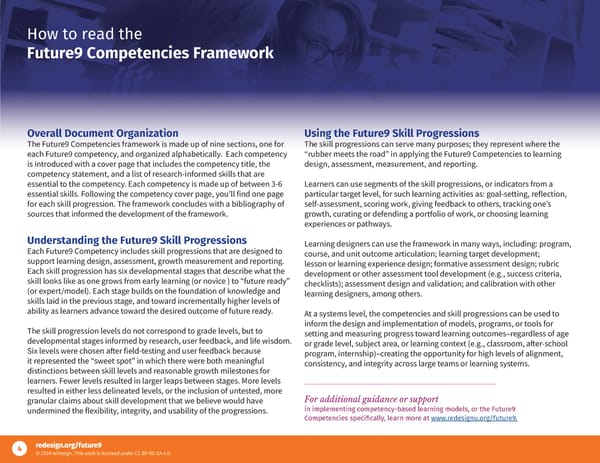How to read the Future9 Competencies Framework Overall Document Organization Using the Future9 Skill Progressions The Future9 Competencies framework is made up of nine sections, one for The skill progressions can serve many purposes; they represent where the each Future9 competency, and organized alphabetically. Each competency “rubber meets the road” in applying the Future9 Competencies to learning is introduced with a cover page that includes the competency title, the design, assessment, measurement, and reporting. competency statement, and a list of research-informed skills that are essential to the competency. Each competency is made up of between 3-6 Learners can use segments of the skill progressions, or indicators from a essential skills. Following the competency cover page, you’ll find one page particular target level, for such learning activities as: goal-setting, reflection, for each skill progression. The framework concludes with a bibliography of self-assessment, scoring work, giving feedback to others, tracking one’s sources that informed the development of the framework. growth, curating or defending a portfolio of work, or choosing learning experiences or pathways. Understanding the Future9 Skill Progressions Learning designers can use the framework in many ways, including: program, Each Future9 Competency includes skill progressions that are designed to course, and unit outcome articulation; learning target development; support learning design, assessment, growth measurement and reporting. lesson or learning experience design; formative assessment design; rubric Each skill progression has six developmental stages that describe what the development or other assessment tool development (e.g., success criteria, skill looks like as one grows from early learning (or novice ) to “future ready” checklists); assessment design and validation; and calibration with other (or expert/model). Each stage builds on the foundation of knowledge and learning designers, among others. skills laid in the previous stage, and toward incrementally higher levels of ability as learners advance toward the desired outcome of future ready. At a systems level, the competencies and skill progressions can be used to The skill progression levels do not correspond to grade levels, but to inform the design and implementation of models, programs, or tools for developmental stages informed by research, user feedback, and life wisdom. setting and measuring progress toward learning outcomes–regardless of age Six levels were chosen a昀琀er field-testing and user feedback because or grade level, subject area, or learning context (e.g., classroom, a昀琀er-school it represented the “sweet spot” in which there were both meaningful program, internship)–creating the opportunity for high levels of alignment, distinctions between skill levels and reasonable growth milestones for consistency, and integrity across large teams or learning systems. learners. Fewer levels resulted in larger leaps between stages. More levels resulted in either less delineated levels, or the inclusion of untested, more granular claims about skill development that we believe would have For additional guidance or support undermined the flexibility, integrity, and usability of the progressions. in implementing competency-based learning models, or the Future9 Competencies speci昀椀cally, learn more at www.redesignu.org/future9. 4
 Future9 Framework Page 3 Page 5
Future9 Framework Page 3 Page 5